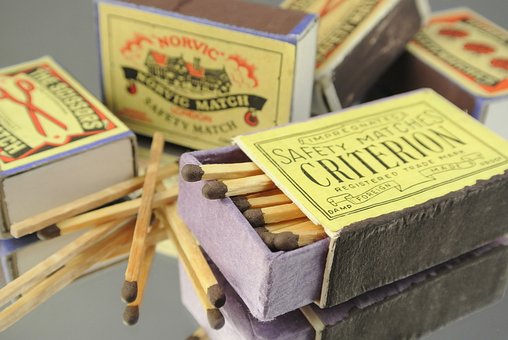Project Report For Match Box Manufacturing
Introduction
Project report for Match Box Manufacturing is as follows.
A matchbox is a box that holds matches and is made of cardboard or thin wood. On one side, it usually features a coarse striking surface for lighting the matches within. To light a safety match, only the striking surface on the match box’s side can be utilised. Sand, powdered glass, and a chemical called “red phosphorous” are used to create a “striking surface.” Cuboids are the basic shape of a matchbox. Matches are purchased in large quantities. There’s the wooden kind that comes in boxes. Paper matches are also available, which are stitched in rows into matchboxs
Project Report Sample Of Match
Box Manufacturing
Get Completely Custom Bankable Project Report
Matches are made in numerous phases. The matchsticks for wooden stick matches are first chopped, prepped, and relocated to a storage location. When necessary, the matchsticks are inserted into holes in a long perforated belt. The belt transports them through the rest of the process, where they are washed, dried, and packaged in boxes. Similarly, cardboard-stick matches used in matchbooks are treated.
Raw materials: The first step in the process is to gather the necessary raw materials, which include cardboard or wood for the box, matchsticks, and striking surface material.
Printing: The cardboard sheets are then printed with the design or logo of the company that is manufacturing the matchboxes. The design can be printed in various colors using a printing machine.
Cutting of matchboxes: The printed cardboard sheets are then cut into small individual matchboxes using a machine. The machine cuts the sheets into the required size and shape.
Making of matches: The matchsticks are made separately in a different process. They are made by dipping wooden sticks into a mixture of chemicals that ignite when rubbed against a rough surface.
Insertion of matches: Once the matchsticks are made, they are inserted into the matchboxes using a machine. The matchsticks are placed in the boxes in an orderly manner.
Sealing: After the matchsticks are inserted, the matchboxes are sealed using a sealing machine. The sealing ensures that the matchsticks stay in place and the boxes are ready for use.
Packaging: The sealed matchboxes are then packaged into larger cardboard boxes for shipping to various destinations. The packaging is done according to the company’s specifications, and the boxes are labeled for easy identification.
Quality control: Before the matchboxes are shipped, they undergo a quality control check to ensure that they are of the required standard. The matchboxes are checked for defects, such as faulty matches or incorrectly sealed boxes.

A match is a small wood or cardboard stick with a hardened mixture of combustible chemicals placed on one end. When that end comes into contact with a rough surface, the friction provides enough heat to ignite the chemicals and create a small flame. Some matches, known as strike-anywhere matches, can be lit by hitting them against any rough surface. Other matches, known as safety matches, will only light when hit on a unique rough surface containing specific chemicals.
They are commonly used to create a fire for cooking in many houses. They’re also utilised in industries to start fires and burn waste materials when heat energy is needed.
In this phase, matchboxes are used to hold match sticks. To make matchbox containers and covers, the paper box manufacturing machine cuts, folds, and glues printed sheets for outer boxes delivered from printing companies.
Market Potential Of Match Box Manufacturing
The matchbox sector has grown dramatically from US$ 31.6 billion in 2011 to US$ 52.75 billion in 2017-18. The sector is expected to develop at a compound annual growth rate (CAGR) of 27.86 percent by 2024, reaching a total value of US$ 103.7 billion. The key development elements in the field have been more awareness, greater access, and changing lifestyles.
Expenses

Product Cost Breakup

Reveneue Vs Expenses

Market Trend

India manufactures four million matchboxes every day, making it the world’s cheapest. One-third of all matchboxes used across the world are from India.
Every year, the industry produces 90 million bundles, each having 600 matchboxes and 40 to 50 sticks in each box. Matchsticks are a high-volume consumer product that requires branding in order to obtain market share. Matchsticks are purchased in large quantities. A robust channel network is critical to the company’s success.
The technology has remained rather simple. Wooden matches make up 82 percent of overall match production, with handcrafted small-scale (67 percent) and cottage (15 percent) enterprises accounting for the rest.
The match industry is classified into numerous sectors based on the magnitude of its output in these two non-automated non-automated non-automated non-automated non-automated non-automated non- The cottage industry in matchmaking is formally defined as any type of matchmaking that is done on a small scale. A manual manufacturing plant box produces less than 75,000 cases per year.
Matchsticks are in great demand, and every day, billions of matchboxes are consumed. Matchsticks are used to start fires, which are necessary for cooking, lighting candles, and smoking cigarettes, among other things. Anyone may establish a matchstick manufacturing business on a small scale while following to rigorous safety rules.
The matchbox industry is India’s fourth-largest employment, with Household and Personal Care accounting for half of all matchbox sales. The urban segment accounts for around 55 percent of the matchbox sector’s overall revenue in India. Rural India’s market has grown at a faster rate than urban India’s in recent years.

